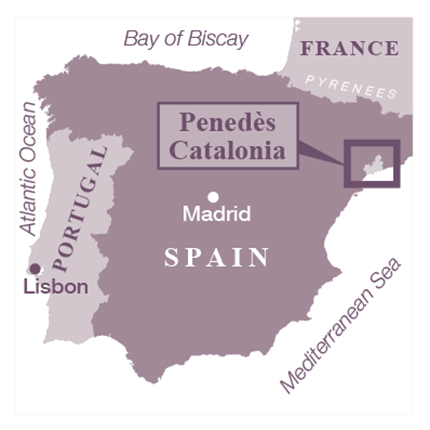A tour of Catalonia’s centres of sparkling wine production is an unbeatable way to immerse yourself in the effervescent lifestyle of the region. Sarah Jane Evans MW is our guide...
Cava travel guide
Planted area 33,325ha of vineyards
Main grapes Macabeo (11,718.38ha), then Xarel.lo and Parellada
Production 242,288,000 bottles
Producers 244 cava; 159 base wine cellars
Ageing Cava is minimum nine months old: Reserva minimum 15 months old; Gran Reserva minimum 30 months old
Residual sugar Brut Nature 0-3g/l Extra Brut 0-6g/l Brut 0-12 g/l
Every wine lover needs to pay homage at cava’s capital, Sant Sadurní d’Anoia, in September. That’s when the town celebrates the 19th-century defeat of phylloxera, which has ravaged vineyards worldwide. People dress up as the infamous, goggle-eyed louse to parade through the streets. The festival tells the story of the rise and defeat of phylloxera, and in the process 4,000 firecrackers are set off and 150 corks popped.
Can’t make September? No worries. The Catalans know how to celebrate year round. In November, the Most (‘Must’ or unfermented grape juice) Festival features films about wine and cava. More traditional is the April festival of the vibrant Catalan folk dance, the sardana. Unlike many, this is still a popular dance, not just one that’s wheeled out for visitors.
Through the spring and summer, be sure to catch the astonishing castells. These are human towers, up to nine or 10 persons high, with people standing on each other’s shoulders, which have been recognised by UNESCO as an Intangible Cultural Heritage of Humanity. The castells, like the sardanas, are popular expressions of firmly held Catalan nationality. Finally, on the first weekend of October, there’s Cavatast in Sant Sadurní d’Anoia, a festival of cava, with wine and food tasting. There’s plenty more to enjoy, all on the www.enoturismepenedes.cat website.
Of course, there’s no such place as cava. It’s the only Spanish denomination not to have its own geographical home. Cava is produced in as many as 159 towns and villages across the country, including in Valencia, La Rioja and Extremadura, as well as Catalonia. However, the vast majority of cava is made in Catalonia. So when talking about holidaying in cava country, that does mean Catalonia, and specifically the region of Penedès.
It’s worth adding here that there are several fine producers who have chosen to opt out of the DO. You will find their wines branded as Clàssic Penedès – such as Albet i Noya, Colet, Loxarel, Mas Bertran – while Raventos i Blanc has created the DO of Conca del Riu Anoia. Don’t forget them when planning your visit.
Cava: All-round attraction
The first cava was made in 1872 by Josep Raventós at Codorníu. The ambition and glamour of those early days are captured in the bodegas of Codorníu and Freixenet. Wine tourism was on the agenda right from the beginning: both of these houses knew about selling and marketing, and they remain the best-selling brands today.
For visitors – even those not interested in the minutiae of wine – cava makes a great visit. The architecturally splendid Codorníu is recognised as a National Monument and offers plenty of tour options. There are wineries with trains (Freixenet – its boutique wineries Casa Sala and La Freixeneda are also interesting); wineries that can show hand disgorging (Recaredo, and other smaller ones); and wineries that set up feasts between January and March to indulge in calçots, the local cross between a leek and a spring onion (Vilarnau, a González Byass-owned winery that offers good trips, including one for children). If you are driving from France, don’t miss Alta Alella, the closest winery to Barcelona, with vineyards that drop down to the sea.

Ageing bottles in the Recaredo cellars.
And then, if the seriousness of wine gets too much, www.hipicasantpau.com (website in Catalan) offers tastings and horseback trips through vineyards. Then there’s always the lure of the glinting Mediterranean: a visit to the Catalan cava houses is an enchanting balance between bottle and beach.
Not forgetting mountain. Dominating the cava towns is Montserrat, a craggy outcrop of pink conglomerate. It’s worth planning a visit to the Benedictine monastery, Santa Maria de Montserrat, to coincide with a performance by the famed Escolania boys’ choir, usually at 1pm in the basilica. Organic producer Llopart offers lovely mountain views.
What I find fascinating now is how cava is escaping from decades of torpor. Gone are the years when cava was the cheaper default from Champagne. Prosecco holds that prize now. Thankfully, many producers are now looking to compete on quality, since they cannot compete on price. For some, that means reducing yields in the vineyards, aiming to get the best out of the local varieties, and giving the wines longer than the minimum bottle age.
Gramona has long been a pioneer in research and has plenty to show the interested visitor – including its own ice wine. Codorníu has an experimental cellar that is producing a new top tier of wines, as well as providing insights into polishing up the mainstream brands.
Cava has decades of expertise in receiving visitors, yet it is easy to be overwhelmed by the slickness of the tourist packages. So it’s worth researching cavas before your trip, writing in advance to your favourite producers to request an appointment. The smaller houses may be more welcoming, as typified by organic grower Castellroig. Less polished than the big names perhaps, but more personal.
A final tip: most of the cava producers’ websites are multilingual. However, if you are visiting a small winery, let them know whether or not you can speak Catalan or Castillian.
How to get there
Fly to Barcelona airport, which is 45 minutes away by car. For planning your visit: www.enoturismepenedes.cat has plenty of ideas and links plus a particularly useful directory of wineries, and list of accommodation.
Sarah Jane Evans MW is a DWWA co-Chair for Spain and chair of the Institute of Masters of Wine.







